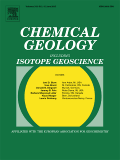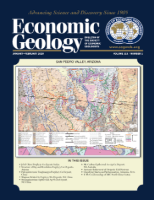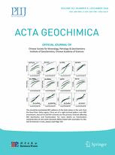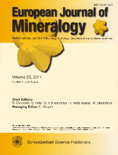
CHEMICAL GEOLOGY
Scope & Guideline
Transforming Geological Knowledge into Actionable Insights
Introduction
Aims and Scopes
- Geochemical Processes in Geological Materials:
The journal emphasizes research on the geochemical composition and processes of various geological materials, including minerals and rocks. This includes studying the chemical interactions between these materials and fluids. - Isotope Geochemistry and Dating Techniques:
A significant focus is placed on the application of isotopic techniques for dating geological events and processes. This includes U-Pb, Rb-Sr, and Lu-Hf dating methods, which help in understanding the timing and evolution of geological formations. - Environmental Geochemistry:
The journal explores the geochemical aspects of environmental issues, such as contamination, nutrient cycling, and the geochemistry of groundwater and surface water. This includes studies on the impacts of human activity on geochemical cycles. - Mineral Formation and Alteration:
Research on mineral formation processes, including crystallization, dissolution, and alteration, is a core component. This encompasses experimental studies that simulate natural processes to understand mineral behavior. - Geochemical Modeling:
The journal publishes studies that involve geochemical modeling to understand complex geological systems. This includes thermodynamic modeling and simulations of fluid-rock interactions and mineral stability. - Petrochemistry and Magmatism:
There is a consistent focus on the geochemical processes involved in magmatism, including the formation and evolution of igneous rocks, and the interactions between magmas and their surrounding environments.
Trending and Emerging
- Advanced Isotope Geochemistry:
There is a growing emphasis on the application of advanced isotopic techniques, such as clumped isotope analysis and multi-isotope approaches, to understand complex geological processes and environmental changes. - Climate Change and its Geochemical Impacts:
Research linking geochemistry to climate change is on the rise. This includes studies on how geochemical cycles are affected by climate variations, and the historical record of climate change preserved in geological materials. - Microbial Geochemistry:
The role of microbes in geochemical processes is gaining attention, particularly in relation to mineral weathering and biogeochemical cycling. Studies are increasingly focusing on how microbial activity influences elemental mobility and mineral formation. - Geochemical Modeling and Simulations:
There is an increasing trend towards using geochemical modeling and simulations to predict mineral behavior and fluid interactions under various conditions, reflecting a more quantitative approach to geochemical research. - Nanogeoscience and Nanoscale Processes:
Research exploring geochemical processes at the nanoscale is emerging, focusing on how nanoscale interactions influence larger geological and environmental systems.
Declining or Waning
- Traditional Geochemical Analysis Techniques:
There seems to be a waning interest in traditional geochemical analysis methods that do not incorporate advanced technologies. As newer methods such as laser ablation and high-resolution isotopic analyses gain traction, classical techniques may be overshadowed. - Generalized Environmental Studies:
Research that broadly addresses environmental geochemistry without specific focus on local or detailed case studies appears to be decreasing. There is a shift towards more precise studies that utilize advanced methodologies to address specific environmental issues. - Basic Mineralogy Studies:
There is a noticeable reduction in publications focused solely on basic mineralogical descriptions without geochemical implications. The trend is moving towards integrating mineralogy with geochemical processes and environmental impacts.
Similar Journals

GEOCHEMISTRY INTERNATIONAL
Exploring the Depths of Earth's ChemistryGEOCHEMISTRY INTERNATIONAL, an esteemed journal published by MAIK NAUKA/INTERPERIODICA/SPRINGER, serves as a vital platform for researchers in the fields of geochemistry, petrology, and geophysics. With a deep history reaching back to its inception, the journal spans significant converged years from 1977 to 1978 and continues its publication through 2024. Although it currently does not offer Open Access options, its scholarly impact is underscored by an established reputation indicated by its Q3 categorization in both Geochemistry and Petrology and Geophysics for 2023. Researchers can leverage this platform to disseminate groundbreaking findings and engage with contemporary discussions in Earth and planetary sciences, where it ranks at the 39th and 32nd percentiles within its respective categories. The journal is an essential resource for professionals, students, and scholars seeking to deepen their understanding of geochemical processes and evolve scientific discourse within this dynamic field.

Periodico di Mineralogia
Fostering Excellence in Earth Science ResearchPeriodico di Mineralogia, published by SAPIENZA UNIV EDITRICE, is a distinguished academic journal based in Italy that has been pivotal in advancing the fields of Geochemistry, Geology, and Geophysics since its inception in 1979. With an ISSN of 0369-8963 and an E-ISSN of 2239-1002, the journal boasts a solid reputation reflected in its Q3 category rankings across these disciplines as per 2023 metrics. The journal’s scope encompasses a broad range of topics related to mineralogy and earth sciences, providing a vital platform for researchers, professionals, and students to disseminate their findings. Despite the absence of an Open Access option, Periodico di Mineralogia remains an essential resource for the dissemination of high-quality research that contributes to our understanding of earth processes and materials. Situated in the heart of Rome at PIAZZALE ALDO MORO 5, it serves as a crucial bridge between academic research and practical applications in geology and planetary sciences.

ECONOMIC GEOLOGY
Connecting Research with Real-World ResourcesECONOMIC GEOLOGY, published by the Society of Economic Geologists, Inc., is a premier journal dedicated to the field of economic geology, geochemistry, petrology, geology, and geophysics. With a significant legacy dating back to 1905 and converging into 2024, this journal has established itself as a leading source of research and knowledge in the geosciences, recognized for its high-quality, peer-reviewed articles that reflect the latest advancements in the discipline. Having achieved an impressive impact factor and categorized in the top Q1 quartiles, it ranks among the foremost journals in various related fields, including Earth and Planetary Sciences—where it particularly excels in geophysics (Rank #5) and geochemistry (Rank #6). Although it currently does not offer open access options, its rigorous publication standards ensure that the research disseminated significantly contributes to the understanding and exploration of geological resources. This journal is essential reading for researchers, professionals, and students who seek to deepen their knowledge and stay at the forefront of economic geology.

CONTRIBUTIONS TO MINERALOGY AND PETROLOGY
Advancing the Frontiers of Mineralogy and PetrologyCONTRIBUTIONS TO MINERALOGY AND PETROLOGY, published by SPRINGER, is a premier journal in the fields of geochemistry, petrology, and geophysics, boasting an impressive impact factor that reflects its status as a leader in the discipline. With a history spanning from 1966 to 2024, this journal has consistently provided a platform for high-quality research that influences our understanding of earth materials and processes. Ranked in the top quartile (Q1) in both geochemistry and petrology, as well as geophysics, it stands out with Scopus rankings of #24 out of 165 in Geophysics and #37 out of 154 in Geochemistry and Petrology, indicating its critical role in advancing scientific knowledge. As a vital resource for researchers, professionals, and students alike, the journal invites contributions that foster collaboration and innovation in the study of minerals and rocks. Although it does not currently offer open access, its scholarly rigor and relevance to contemporary issues ensure it remains an indispensable part of the academic discourse within this field.

Geochemical Perspectives Letters
Empowering the global community with open-access geochemical insights.Geochemical Perspectives Letters, published by the European Association of Geochemistry, is a leading open-access journal that has been at the forefront of geochemical research since its inception in 2015. Based in France, this journal is dedicated to disseminating high-quality, original research and reviews across the fields of Environmental Chemistry, Geochemistry, and Petrology, and Geology. With an impressive Q1 ranking in multiple categories, and notable Scopus rankings placing it among the top-tier journals in Earth Sciences, Geochemical Perspectives Letters aims to foster scientific dialogue and collaboration among researchers and professionals. Its open-access model ensures widespread dissemination of knowledge, making it accessible to a diverse audience, including students and seasoned experts alike. As the journal continues to converge research insights from 2015 to 2024, it remains a pivotal resource for those striving to understand and address the complexities of our planet's geochemical processes.

ORE GEOLOGY REVIEWS
Shaping the Future of Geological SciencesORE GEOLOGY REVIEWS is a premier academic journal published by Elsevier, renowned for its influential contributions to the fields of Economic Geology, Geochemistry, and Petrology, and Geology. With its esteemed Q1 ranking across these disciplines in 2023, it occupies a leading position in shaping scholarly discussions and advancements within the geological sciences. With an impressive Scopus ranking—47th in Earth and Planetary Sciences for Geology, and among the top 40 in Geochemistry and Petrology—this journal serves as an essential resource for researchers, professionals, and students committed to advancing knowledge in ore geology. Having transitioned to an Open Access model in 2022, ORE GEOLOGY REVIEWS enhances the accessibility of high-quality research, promoting wider dissemination and engagement with cutting-edge findings from 1986 to 2024. As a valued publication addressing the intricacies of ore deposits and geochemical processes, it aims to foster interdisciplinary collaboration and innovation in the field.

GEOCHEMICAL JOURNAL
Fostering Interdisciplinary Collaboration in GeoscienceGEOCHEMICAL JOURNAL, published by the Geochemical Society of Japan, stands as a pivotal platform for researchers and professionals dedicated to the fields of geochemistry and petrology, as well as geophysics. With the ISSN 0016-7002 and E-ISSN 1880-5973, this journal has been disseminating cutting-edge research since its inception in 1966 and continues to provide invaluable insights into the complexities of Earth's processes. Currently categorized in the Q3 quartile for both Geochemistry and Petrology and Geophysics, the journal ranks in the 40th and 36th percentiles, respectively, as per Scopus metrics, reflecting its growing influence and relevance in the scientific community. The journal accepts a range of scholarly articles, aiming to foster a deeper understanding of geochemical phenomena while promoting interdisciplinary collaboration among academicians and practitioners. Although not open access, the GEOCHEMICAL JOURNAL's commitment to quality research and education underscores its vital role in advancing the discourse within geoscience.

Acta Geochimica
Unveiling the Mysteries of Earth and Beyond.Acta Geochimica is a prominent academic journal published by SPRINGER INT PUBL AG, focusing on the dynamic fields of Geochemistry and Petrology. Established in 2016, this peer-reviewed publication has quickly gained recognition within the scientific community, currently holding a category quartile ranking of Q3 in Geochemistry and Petrology as of 2023. With its ISSN 2096-0956 and E-ISSN 2365-7499, the journal offers a platform for researchers and professionals to disseminate and discuss significant advancements in the study of the chemical composition of the Earth and other celestial bodies. While it is not an open-access journal, Acta Geochimica plays a vital role in fostering collaboration and innovation among scientists, contributing to a deeper understanding of geochemical processes. Located in Switzerland at Gewerbestrasse 11, Cham CH-6330, Switzerland, this journal is a critical resource for students, researchers, and professionals seeking to push the boundaries of knowledge in Earth sciences.

EUROPEAN JOURNAL OF MINERALOGY
Connecting researchers to the core of mineralogical research.The EUROPEAN JOURNAL OF MINERALOGY, published by COPERNICUS GESELLSCHAFT MBH, is a pivotal open-access journal dedicated to advancing the fields of Geochemistry and Petrology. With a rich history spanning from 1989 to 2024, this journal has established itself as a key resource for researchers and professionals alike, achieving a commendable Q2 category ranking in its field for 2023. Its inclusion in the Scopus database ranks it 79 out of 154 in Earth and Planetary Sciences, reflecting its impact within the scientific community. With an open access model since 2020, the journal facilitates broad dissemination of high-quality research findings, thereby enhancing accessibility and engagement among scholars and students globally. Set against the backdrop of Germany’s vibrant academic landscape, the EUROPEAN JOURNAL OF MINERALOGY continues to play a crucial role in fostering dialogue and innovation in mineralogical sciences.

JOURNAL OF GEOLOGY
Illuminating the Path of Geological Discovery.The JOURNAL OF GEOLOGY, published by University of Chicago Press, serves as a premier platform for disseminating groundbreaking research in the field of geology. Established in 1973, this esteemed journal has consistently ranked in the Q2 category in geology, further solidified by its Scopus ranking, where it is positioned at 99 out of 321 in Earth and Planetary Sciences, marking it in the 69th percentile of its category. With an emphasis on innovative and interdisciplinary studies, the journal features peer-reviewed articles that contribute to the understanding of geological processes, earth materials, and environmental interactions. Although it does not currently offer open access, it facilitates broad access through academic institutions to reach a global audience of researchers, professionals, and students striving to advance the knowledge of Earth's history and dynamics. As a vital resource for the geology community, the JOURNAL OF GEOLOGY plays an essential role in fostering scholarly dialogue and advancing both academic inquiry and practical applications in geology.